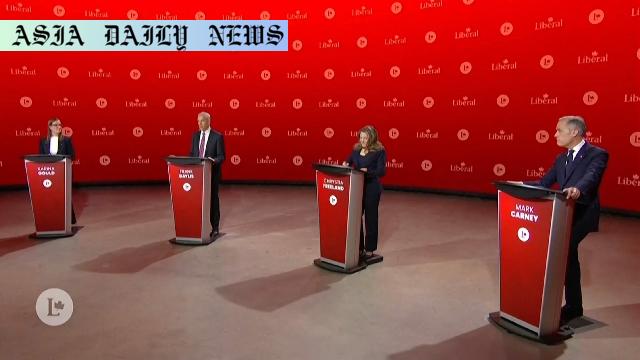Liberal Party leadership. Canada’s ruling Liberal Party is set to elect a successor to Prime Minister Justin Trudeau amidst political shifts.
- Canada’s Liberal Party will select a new leader to succeed Prime Minister Justin Trudeau.
- Four key contenders include Chrystia Freeland and Mark Carney, among others.
- Candidates are proposing countermeasures for US tariffs and dependency reduction.
- Trudeau’s low approval rating prompted his decision to step down.

Canada’s Liberal Party at a Crossroads
The ruling Liberal Party of Canada is gearing up to elect a new leader as Prime Minister Justin Trudeau prepares to step down after nearly eight years in office. This leadership race comes at a critical juncture for Canada, following rising discontent over Trudeau’s handling of pressing issues like the high cost of living and strained US-Canada relations. The leadership change will mark a fresh chapter for the party and the nation, as Canadians increasingly demand solutions to ongoing socio-economic challenges.
One of the headline contenders is Chrystia Freeland, a former deputy prime minister and finance minister known for her economic expertise. She resigned in protest against Trudeau’s policies, signaling her intent to chart a different course for Canada. Another prominent name is Mark Carney, a respected economist and former Governor of the Bank of Canada. Their leadership credentials elevate this race to a critical level of importance, as they offer contrasting visions to reinvigorate Canada’s political and economic future.
The Elephant in the Room: US Relations
A key issue dominating this leadership race is Canada’s relationship with the US. Under former president Donald Trump, tensions between the two North American neighbors reached new heights, with Trump openly suggesting Canada become the 51st state. This provocative stance, coupled with newly imposed 25% tariffs on Canadian and Mexican imports, has deeply affected Canadian industries and citizens.
While Trudeau’s administration sought to maintain diplomatic ties with the US, the leadership candidates agree more robust countermeasures are warranted. Many suggest targeting alternative trade markets outside the US to reduce reliance and developing policies to implement retaliatory tariffs, reflecting a growing sense of nationalism within Canada. These strategies will undoubtedly shape public opinion on who should lead post-Trudeau.
Public Sentiment and Trudeau’s Legacy
Prime Minister Trudeau’s announcement to step down comes after dwindling approval ratings and frustrations over the cost-of-living crisis in Canada. His government has been criticized for failing to address inflation and housing affordability, with many Canadians expressing a desire for change. While Trudeau’s agenda focused on progressive policies like climate initiatives and social reforms, his perceived lack of action on everyday economic struggles damaged his standing.
The new leader faces dual challenges of addressing these domestic concerns while navigating the complexities of international diplomacy, particularly with Canada’s largest trading partner, the US. The leadership election holds promise as Canadians look for fresh strategies to restore economic balance and political stability.
An official announcement regarding Trudeau’s successor is anticipated after the weekend’s voting closes. This allows a crucial window for citizens to reflect on the kind of future they envision for the nation under new leadership.



Commentary
Trudeau’s Resignation and the Winds of Change
Justin Trudeau’s decision to step down as Canada’s Prime Minister marks the end of a significant political era in the country. While he was initially seen as a progressive beacon for Canadians, his leadership journey has been a mixed bag of commendable achievements and evident shortcomings. Trudeau’s legacy is likely to stir debates in coming years, particularly on the effectiveness of his governmental reforms amidst rising challenges such as inflation and international political tensions.
His resignation also reflects the inevitable political cycle where leadership renewal becomes necessary to regain public trust. Trudeau has undoubtedly left an indelible mark on the Liberal Party, though the new leader will have to navigate uncharted waters. They’ll need to strike a balance between aligning with their predecessor’s progressive values while demonstrating a willingness to address Canada’s glaring socio-economic needs—chief among them being affordable housing, living costs, and trade independence.
Challenges Facing the Next Leader
Whoever emerges victorious in this tightly contested leadership race inherits significant challenges both at home and abroad. Domestic discontent over the cost of living has reached new heights in recent years, with many Canadians advocating for immediate relief measures. The leadership candidates will likely find themselves under immense pressure to address these growing concerns effectively. Failure to offer palpable solutions could spell trouble for the Liberal Party’s political longevity.
On the global stage, relations with the United States loom large. Donald Trump’s overtly antagonistic view of Canada underlines the necessity for policies that redefine Canada-US relations. The Canadian public undoubtedly hopes the new leader takes a strong stance on such issues, prioritizing the country’s economic independence while maintaining stable diplomacy.
The Road Ahead for Canada’s Liberal Party
Looking forward, this leadership shift presents a unique opportunity for the Liberal Party to revolutionize its approach and reconnect with voters. The new leader’s strategic decisions will profoundly influence not only the direction of the party but also the socio-economic and political future of Canada. Canadians now demand transformative policies that connect with their real-world concerns, not just promises.
This leadership race thus sets the stage for a historic political transition. The chosen successor has big shoes to fill, leading a nation at a complex crossroad. Only time will tell whether they rise to the challenge and mark the beginning of a brighter era for Canada’s Liberal Party.